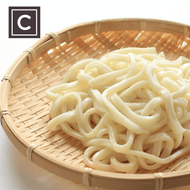Ingredient Glossary: Udon Noodles
Posted by Emily on 1st Dec 2019 Reading Time:
What Are Udon Noodles?
Udon noodles are a staple of Japanese cuisine, known for their thick, white, and somewhat ribbon-like appearance. These noodles are primarily crafted from strong white wheat flour, salt, and water. You can enjoy them either hot or cold, making them a versatile component for various dishes, from steaming soups to refreshing salads. Slurping the noodles is not just allowed but encouraged in Japan, adding to the overall enjoyment of the dish.
Types and Availability
The essential ingredients for udon are straightforward, but regional variations exist. Some versions use potato starch or even incorporate carrots for an orange hue. While they're most commonly found in a round or square shape, they can also appear as flat ribbons.
Udon noodles can be purchased in various forms, including dried, frozen, or pre-cooked. Although they're more expensive than typical pasta, you can easily find them in grocery stores, Asian markets, and online. Asian markets usually offer a broader selection, and freshly made udon is more commonly available in Japan.
Udon vs Soba Noodles
Both udon and soba noodles are celebrated in Japanese cuisine. While udon is crafted from white wheat flour, soba is made from buckwheat flour and has a darker colour, along with a nuttier flavour. Soba noodles are usually thinner, resembling spaghetti. Both can appear in similar dishes, but using one over the other changes the overall dining experience.
Cooking Instructions
Homemade Udon
Mix flour, salt, and water into a dough, kneading until smooth to make your own udon noodles. Allow it to rest, covered, for at least an hour. Roll out the dough on a floured surface, continually rotating it until it reaches your desired thickness (usually just under 1/4-inch). Cut into noodles and cook in simmering water for 5 to 10 minutes until they float to the top.
Packaged Udon
For dried udon, boil for about 8 to 12 minutes, tasting for texture. Frozen or fresh varieties usually don't require defrosting. Always follow the specific package instructions. Use ample boiling water for all types to prevent sticking.
How to Serve
Udon is commonly featured in soups such as kake udon, which comprises simply of noodles and broth, or more complex dishes with curry or red miso broths. Popular toppings include tempura, fried tofu, shrimp, egg, and various meats and vegetables. Alternatively, try them cold in a salad or with a dipping sauce, such as in zaru udon.
Alternative Choices
If you're interested in something a bit different, soba noodles make a good alternative. They can be prepared and served similarly to udon but provide a distinct taste and texture.
Ideas
Consider mixing udon with sesame seeds, fresh ginger, dried seaweed, or wasabi for a cold dish. Combine udon noodles with prawns and vegetables for a hot dish, or incorporate them into Asian-style soups.
By knowing the ins and outs of udon, you can truly appreciate this Japanese staple's versatility and rich traditions. Whether in soups or salads, hot or cold, udon offers a satisfying dining experience.



